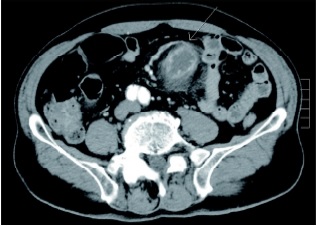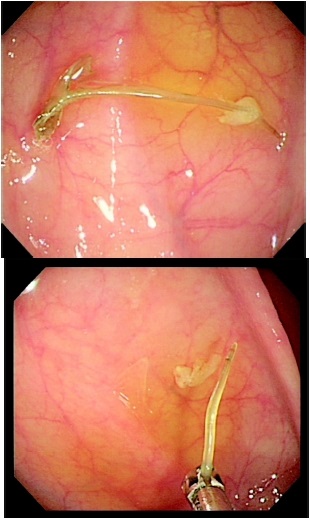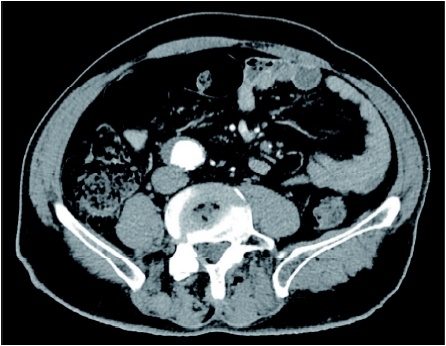Kosin Med J.
2018 Dec;33(3):415-421. 10.7180/kmj.2018.33.3.415.
A case of intra-abdominal abscess caused by unconsciously ingestion of fish bone in elderly patient
- Affiliations
-
- 1Department of Internal Medicine, Gyeongsang National University School of Medicine and Gyeongsang National University Hospital, Jinju, Republic of Korea. khj9454@hanmail.net
- KMID: 2442554
- DOI: http://doi.org/10.7180/kmj.2018.33.3.415
Abstract
- Cases showing complications such as esophageal injury, deep neck infection, and mediastinitis caused by accidental ingestion of fish bone are common. But ingestion of fish bone rarely causes perforation of the gastrointestinal tract or an intra-abdominal abscess. We report herein a case of a 78-year-old man with a periumbilical mesenteric abscess caused by fish bone which was ingested unconsciously. The fish bone was found in the terminal ileum and it was removed by colonoscopy. The patient improved and he was discharged after systemic antibiotic therapy. Occasionally, when patients swallow fish bone without a foreign body sensation, clinicians should suspect perforation caused by fish bone in case of an intra-abdominal abscess of unknown cause.
Keyword
MeSH Terms
Figure
Reference
-
1. Omoto T, Endo S, Ikehara K, Hidaka E, Ishida F, Tanaka J, et al. [A case of cecal cancer with abdominal wall abscess]. Gan To Kagaku Ryoho. 2012; 39:297–299.2. Lizarralde E, Martínez Odriozola P, Tobalina I, Maniega R, Miguel F. [Intra-abdominal abscess as presentation of colonic cancer]. An Med Interna. 2000; 17:32–34.3. Kumar RR, Kim JT, Haukoos JS, Macias LH, Dixon MR, Stamos MJ, et al. Factors affecting the successful management of intra-abdominal abscesses with antibiotics and the need for percutaneous drainage. Dis Colon Rectum. 2006; 49:183–189.
Article4. Abel RM, Fischer JE, Hendren WH. Penetration of the alimentary tract by a foreign body with migration to the liver. Arch Surg. 1971; 102:227–228.
Article5. Henderson CT, Engel J, Schlesinger P. Foreign body ingestion: review and suggested guidelines for management. Endoscopy. 1987; 19:68–71.
Article6. Vizcarrondo FJ, Brady PG, Nord HJ. Foreign bodies of the upper gastrointestinal tract. Gastrointest Endosc. 1983; 29:208–210.
Article7. Leijonmarck CE, Fenyö G, Räf L. Nontraumatic perforation of the small intestine. Acta Chir Scand. 1984; 150:405–411.8. Singh RP, Gardner JA. Perforation of the sigmoid colon by swallowed chicken bone: case reports and review of literature. Int Surg. 1981; 66:181–183.9. Dabadie A, Roussey M, Betremieux P, Gambert C, Lefrancois C, Darnault P. Acute pancreatitis from a duodenal foreign body in a child. J Pediatr Gastroenterol Nutr. 1989; 8:533–535.
Article10. Sukhotnik I, Klin B, Siplovich L. Foreign-body appendicitis. J Pediatr Surg. 1995; 30:1515–1516.
Article11. Broome CJ, Peck RJ. Hepatic abscess complicating foreign body perforation of the gastric antrum: an ultrasound diagnosis. Clin Radiol. 2000; 55:242–243.
Article12. Goh BK, Chow PK, Quah HM, Ong HS, Eu KW, Ooi LL, et al. Perforation of the gastrointestinal tract secondary to ingestion of foreign bodies. World J Surg. 2006; 30:372–377.
Article13. Lee KF, Chu W, Wong SW, Lai PB. Hepatic abscess secondary to foreign body perforation of the stomach. Asian J Surg. 2005; 28:297–300.
Article14. Ngan JH, Fok PJ, Lai EC, Branicki FJ, Wong J. A prospective study on fish bone ingestion. Experience of 358 patients. Ann Surg. 1990; 211:459–462.15. Chen CK, Su YJ, Lai YC, Cheng HK, Chang WH. Fish bone-related intra-abdominal abscess in an elderly patient. Int J Infect Dis. 2010; 14:e171–e172.
Article
- Full Text Links
- Actions
-
Cited
- CITED
-
- Close
- Share
- Similar articles
-
- Bacteremia Caused by Eggerthella lenta in an Elderly Patient with an Intra-abdominal Abscess
- A Case of Fish Bone Induced Colon Perforation Presented as an Intraabdominal Mass
- Gastric Pseudotumoral Lesion Caused by a Fish Bone Mimicking a Gastric Submucosal Tumor
- A Case of Focal Intramural Abscess Due to a Fish Bone Ingestion in a Healthy Middle Aged Woman
- Gastric Wall Abscess Caused by a Fish Bone and Treated with Endoscopic Management





